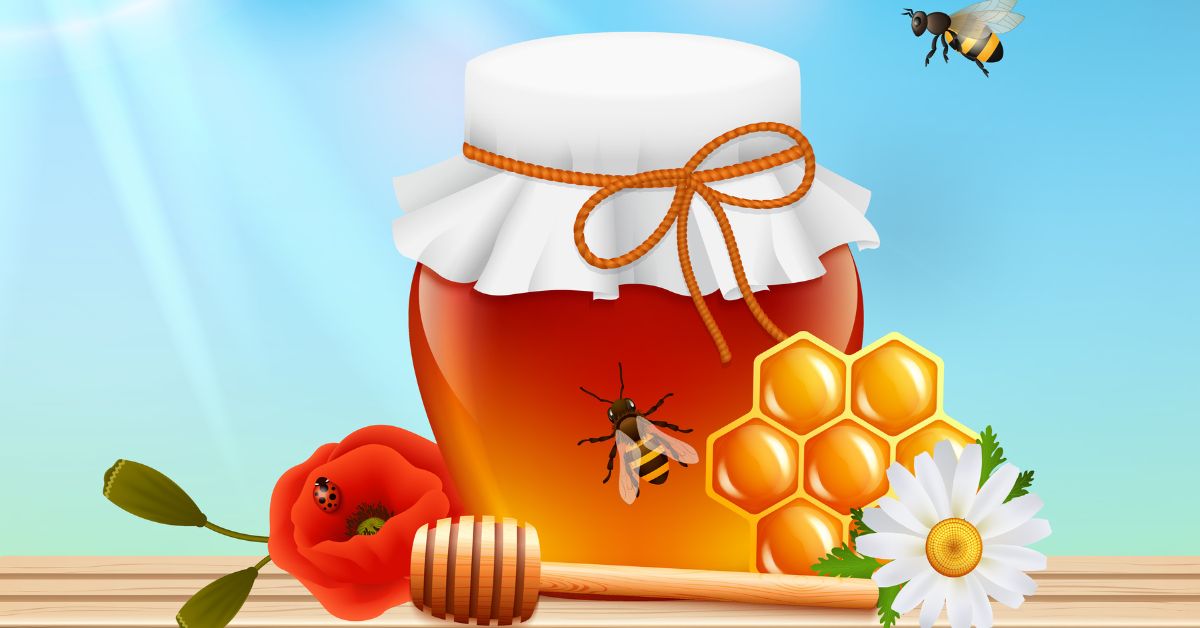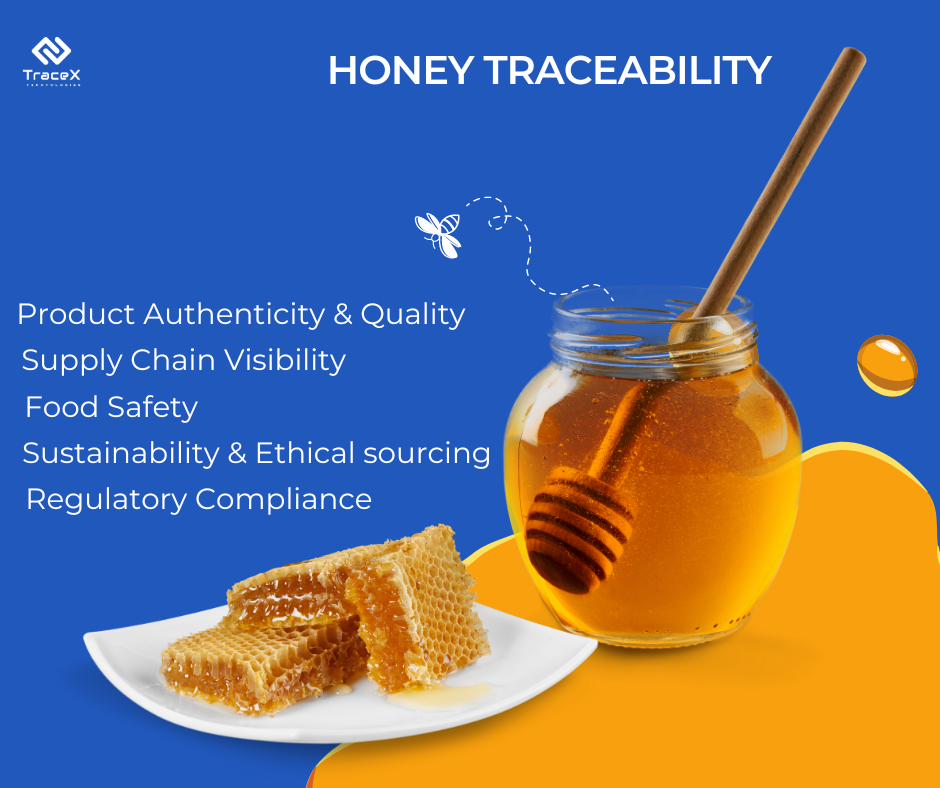Contact: +91 99725 24322 |
Menu
Menu
Quick summary: Explore the fascinating journey from hive to honey with our comprehensive guide on traceability in the honey production process. Learn how advanced technologies like blockchain are revolutionizing the industry, ensuring transparency and quality every step of the way.

With consumers increasingly valuing transparency and authenticity in their food choices, honey traceability is a measure of trust and accountability. Delving into the hive-to-honey traceability journey illuminates the intricate steps involved in harvesting nature’s golden nectar, from the buzzing hives of beekeepers to the jars of pure, unadulterated honey on store shelves.
According to FoodChainID, a compliance management company, honey ranks as the third most counterfeited food globally, trailing only behind milk and olive oil.
Honey, with its natural sweetness and health benefits, has been a favourite for centuries. However, recent concerns about adulteration and unethical practices in honey production have led to a demand for greater transparency. Consumers want to know where their honey comes from and whether it has been collected and processed responsibly.
Counterfeit honey adversely affects beekeepers and leads to increased strain on bees due to extended pollination efforts, resulting in fatigue.
Hive to honey traceability refers to the capacity to track honey’s path from the hive to the ultimate customer. This entails documenting every stage of production, including beekeeping, harvesting, processing, and packaging, typically using labelling or digital tracking systems.
Traceability is important in the honey manufacturing process for a variety of reasons.
The honey value chain encompasses the entire system of production, processing, and marketing of honey, from its inception to the finished product.
Beekeeping procedures refer to the strategies and methods used to raise and care for honeybees. This includes choosing appropriate hive locations, ensuring correct nourishment, monitoring bee health, controlling pests and diseases, and harvesting honey. Beekeepers frequently use a variety of instruments and equipment, including hives, smokers, and protective gear, to safeguard the health of their colonies.
Effective hive management is critical to both honey quality and traceability. Proper hive maintenance promotes robust bee populations, which produce high-quality honey. By carefully managing hives, beekeepers can reduce the possibility of contamination or adulteration, ensuring that honey fulfils quality standards. Furthermore, rigorous hive records and management methods aid traceability efforts, allowing producers to precisely identify the honey’s origin and production process from hive to customer, fostering transparency and consumer trust in the product.
Pollination is a vital process for honey production, playing a crucial role in the reproduction of flowering plants that produce nectar, the primary ingredient of honey. Bees, among other pollinators, are key players in this process. This not only ensures the continued growth and survival of plant species but also directly impacts crop yield, as many agricultural crops rely on pollination for successful fruit and seed production. Moreover, pollination contributes to biodiversity by supporting the health and diversity of plant communities, which in turn sustains a wide range of animal species and ecosystem functions. Thus, understanding and preserving the pollination process is essential for both honey production and the overall health of agricultural and natural ecosystems.
Honey harvesting involves a meticulous process of collecting honey from beehives, typically done during specific seasons when honey production peaks. This process includes several steps, such as removing honey-filled frames from the hive, uncapping the wax seal covering the honeycomb cells, and using specialized equipment like honey extractors to spin the frames and extract the honey. Proper harvesting techniques are crucial for ensuring the quality and purity of the honey. Careful handling of the honeycomb frames prevents contamination and preserves the natural flavors and nutritional properties of the honey. Additionally, using appropriate tools and equipment minimizes damage to the honeycomb and reduces the risk of introducing impurities or foreign substances. By adhering to best practices in honey harvesting, beekeepers can maintain the integrity of their honey products and provide consumers with high-quality, delicious honey.
Honey processing involves several important steps to transform raw honey into a market-ready product. The process begins with the removal of any debris, such as beeswax, dead bees, or other impurities, from the harvested honeycomb frames. Once cleaned, the honey undergoes filtering to remove fine particles and air bubbles, resulting in a smoother and clearer appearance. Pasteurization, a heat treatment process, is often employed to eliminate any potential harmful bacteria and enzymes, extending the shelf life of the honey. Finally, the processed honey is packaged into jars, bottles, or other containers, ready for distribution and consumption. Each step in the processing ensures that the honey meets quality standards and retains its natural flavor, aroma, and nutritional benefits, providing consumers with a safe and enjoyable product.
Distribution and retail are crucial aspects of the honey industry, ensuring that honey products reach consumers effectively. Honey is distributed through various channels, including retail stores, farmers’ markets, online platforms, and specialty stores. Effective labeling and packaging play a significant role in marketing honey products, as they not only provide essential information about the product but also serve as a tool to attract consumers’ attention. Eye-catching labels and packaging designs can differentiate honey products from competitors and communicate their quality and unique attributes.
Pesticides, habitat loss due to urbanization and deforestation, climate change, and the spread of diseases and parasites like Varroa mites all contribute to the decline in bee populations. These factors not only endanger the survival of bee colonies but also jeopardize the overall ecosystem’s health and biodiversity.
With the rising demand for honey and the lucrative market it commands, there is a growing incentive for fraudulent practices such as honey adulteration. Adulteration involves mixing pure honey with cheaper sweeteners or additives, compromising its quality and nutritional value. Detecting adulteration is difficult, and without stringent quality control measures and regulatory oversight, consumers may unknowingly purchase adulterated honey, leading to concerns about food safety and authenticity.
The global honey market is highly competitive, with numerous producers and suppliers vying for market share. Price fluctuations, influenced by factors such as supply and demand dynamics, seasonal variations in honey production, and international trade policies, pose challenges for both producers and consumers. Additionally, the prevalence of counterfeit or low-quality honey products in the market exacerbates competition and pricing pressures, making it challenging for genuine producers to maintain profitability and consumer trust.
Sustainable beekeeping practices are integral to ensuring the long-term viability of honey production and safeguarding the health of bee populations and ecosystems. With bees playing a crucial role in pollination and ecosystem health, sustainable beekeeping practices prioritize the well-being of bee colonies, the preservation of natural habitats, and the promotion of biodiversity.
One of the key aspects of sustainable beekeeping is the promotion of bee health and habitat conservation. This involves providing bees with access to diverse and pesticide-free forage sources, maintaining suitable nesting sites, and minimizing stress factors such as disease exposure and habitat loss. Initiatives such as planting pollinator-friendly flora, establishing bee-friendly landscapes, and implementing integrated pest management strategies help create conducive environments for bees to thrive.
Various certification programs and standards have been developed to promote sustainable honey production and beekeeping practices. These programs often include criteria related to bee welfare, environmental stewardship, and social responsibility. For example, the Certified Naturally Grown (CNG) and Bee Better Certified programs focus on sustainable agricultural practices that support pollinators and enhance biodiversity. Similarly, certifications like Organic and Fair Trade ensure that honey is produced using environmentally friendly methods and that beekeepers receive fair compensation for their labor.
If your farm abstains from GMOs, pesticides, synthetic fertilizers, and prioritizes ecological harmony, you might qualify for Certified Naturally Grown (CNG) certification. Tailored for farmers cultivating food for local communities, CNG encompasses various operations including produce, flowers, mushrooms, bees, livestock, and aquaponics.
Traceability technologies are critical to providing transparency and accountability in the honey sector, allowing stakeholders to monitor the passage of honey from the hive to the customer. These technologies use a variety of approaches, including blockchain, RFID (Radio Frequency Identification), and barcodes, to produce a digital trail of data about the honey producing process.
Blockchain technology creates a decentralised and immutable ledger that records all transactions and events throughout the honey supply chain. Each member in the chain, from beekeepers to retailers, can contribute data, resulting in a transparent and tamper-proof record of the honey’s journey. RFID tags with unique identifiers can be placed to hives or honey containers, enabling real-time tracking and monitoring throughout the production and distribution processes. Similarly, barcodes provide a cost-effective traceability option, with each code providing product information that can be scanned at multiple points along the supply chain, allowing for quick and accurate identification and validation of honey products. These technologies improve traceability, ensuring product purity and giving consumers greater trust in the honey they buy.
Explore how blockchain revolutionizes food traceability, ensuring transparency, integrity, and trust throughout the supply chain.
Uncover the Secrets of Food Traceability with Blockchain!
TraceX blockchain solution plays a pivotal role in addressing the challenges faced in the honey value chain, particularly in ensuring transparency, traceability, and authenticity throughout the production process.
1. Traceability and Transparency: TraceX utilizes blockchain technology to create an immutable and transparent ledger of transactions, allowing every step of the honey production process to be recorded and traced. From hive management and pollen collection to harvesting, processing, and distribution, each stage is documented on the blockchain, providing stakeholders with real-time visibility into the journey of honey from hive to table. This level of traceability helps identify any potential issues or bottlenecks in the supply chain, enabling timely intervention and quality assurance.
2. Quality Control and Adulteration Prevention: With TraceX, data on honey quality parameters, such as moisture content, purity, and chemical composition, can be securely recorded on the blockchain. This ensures that honey meets the required quality standards and helps prevent adulteration or contamination along the supply chain. By enabling transparent documentation of quality control measures and test results, TraceX instils confidence in consumers regarding the authenticity and safety of honey products.
3. Market Competition and Pricing Challenges: TraceX enhances market transparency by providing stakeholders with access to accurate and up-to-date information on honey production, inventory levels, and market demand. This enables beekeepers, processors, and distributors to make informed decisions regarding pricing, inventory management, and market positioning. By facilitating fair competition and pricing transparency, TraceX contributes to a more equitable and competitive honey market.
4. Sustainable Practices and Certification Compliance: TraceX supports sustainability initiatives by allowing beekeepers to document their adherence to sustainable beekeeping practices on the blockchain. This includes recording data on habitat conservation efforts, pesticide usage, and bee health management. Additionally, TraceX can facilitate the verification and certification of sustainable honey production practices, helping beekeepers comply with certification standards and access premium markets for sustainably produced honey.
Discover the journey of Svojas Farms towards a trusted consumer brand with Blockchain traceability for its honey products.
Dive into their success story with TraceX!

To summarise, traceability technologies are becoming increasingly important for ensuring authenticity, quality, and transparency in the honey sector. Despite hurdles such as various stakeholder involvement, interoperability issues, and cost considerations, traceability technologies such as blockchain, RFID, and barcodes are becoming increasingly popular. These solutions not only meet consumer demand for ethically sourced and sustainable products, but they also help with regulatory compliance and reduce the dangers of adulteration and contamination. Furthermore, future trends like IoT integration and blockchain platforms represent continued innovation in hive-to-honey traceability, promising even greater efficiency and sustainability. Finally, by embracing traceability technologies, the honey sector can increase consumer trust, improve product purity, and create a more robust and transparent supply chain environment.
